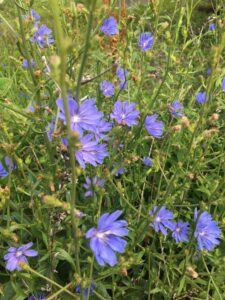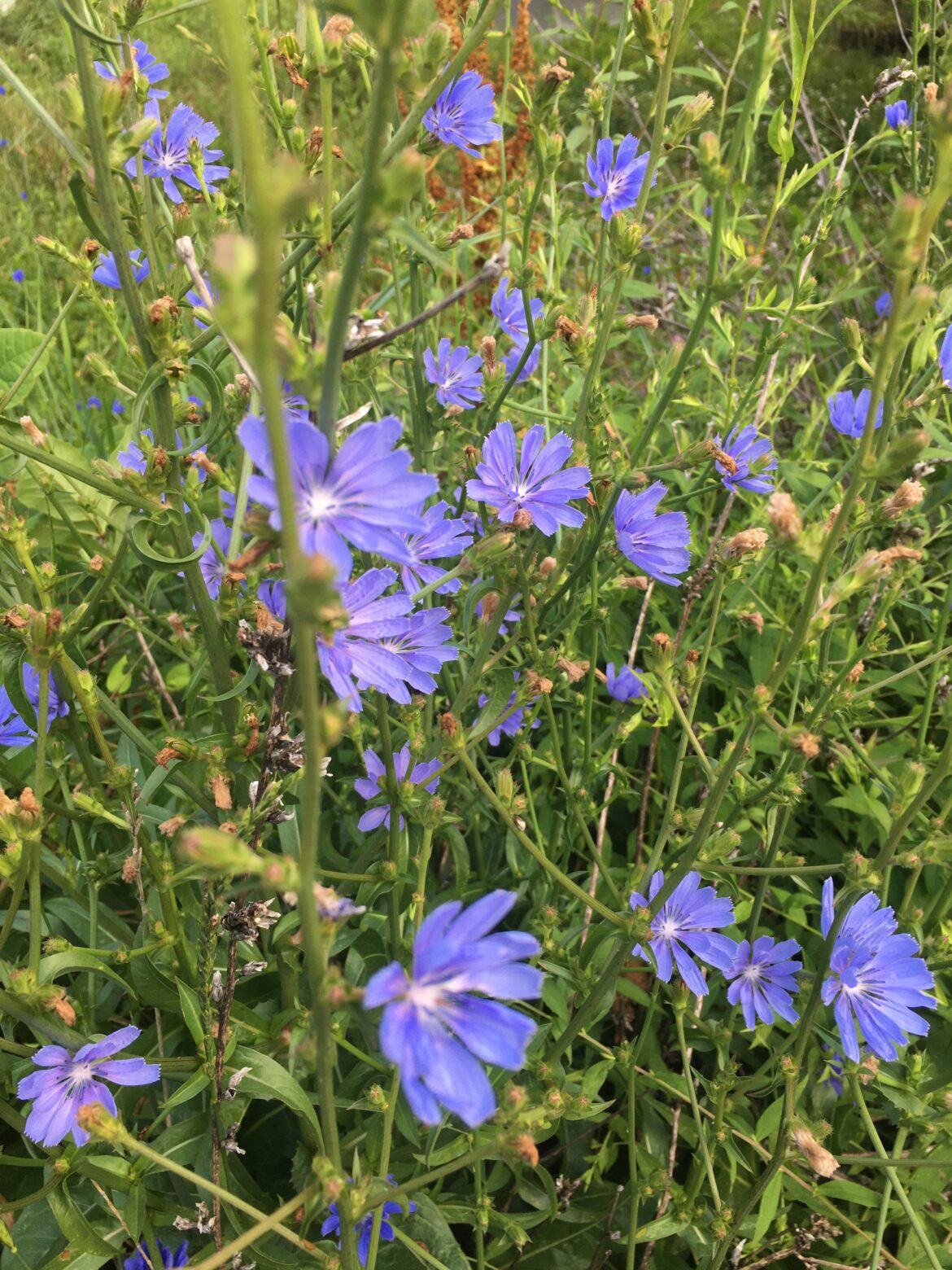July 6th 
The 187th Day of the Year
Hot weather? Yes; but really not
Compared with weather twice as hot.
James Whitcomb Riley
Sunrise/set: 5:13/8:07
Day’s Length: 14 hours 54 minutes
Average High/Low: 85/64
Average Temperature: 74
Record High: 100 – 1911
101 – 2012
Record Low: 44 – 1972
Weather
This is typically the driest day in the first two weeks of July. Showers fall only 30 percent of all the years. Cool temperatures in the 70s can be expected 35 percent of the time, but 80s come on 20 percent of the years, and 90s on 45 percent. Lows in the 50s occur on a third of the nights, 60s and 70s on the rest.
Natural Calendar
Elderberry flowers turn to fruit, like the blossoms of pokeweed, poison ivy and the trilliums. August’s goldenrod is six-feet tall now. Lupine pods break apart to spread their seeds. Early white snakeroot, ironweed, Joe Pye weed, boneset, wingstem and tall coneflowers are budding. Summer reaches critical mass: so much color, so much new life, so much perfection that the weight of one more insect or the exotic scent of one more milkweed or the ecstasy of one more butterfly suddenly pierces the spinning ascension of time, and the season topples over of its own weight, the last infinitesimal addition pulling the vast Earth over into full Deep Summer, tilting it top heavy toward equinox.
Daybook
1983: Baby blue jay dead on the sidewalk in front of the house this morning. At South Glen, a flock of goldfinches rose from the thistle down as I walked by. Some black-eyed Susans, a moneywort left over, scattered late rockets, galls on the goldenrod, wingstem deep and tall, some loosestrife, dogbane and wood mint blooming. And the large pink Virginia roses still full bloom. Early germander, yarrow full and rich, some tall cinquefoil. But no tall bellflowers – they’re late this year – or I’ve missed their habitat. Paths full of white clover, but the tall sweet clovers are fading quickly. The angelica’s stems are old and red, seeds black. Flies and mosquitoes pesky but kept somewhat at bay by a cool northwest wind when I was in the open. A rare July day, cool enough for a jacket.
1984: Black raspberry peak is over.
1986: South Glen: large berries on the blue cohosh. Flock of seventeen geese along the river: the young are nearly grown now, but not completely marked. They moved upstream single file along the shore where the water is calmest. One black walnut on the path, sign of deep Deep Summer. Daddy-longlegs: five of them shared a milkweed flower with the motionless, ecstatic, mating milkweed beetles. First stag beetle seen. Sycamore bark coming down. Very first teasel in flower. Green wild cherries hanging in clusters. Buds on the ironweed and wild lettuce. Long round thimbles on the thimbleweed. Tiny water striders are out, maybe an eighth of an inch, born this month. Fringed loosestrife, germander full bloom. Angelica leaves turning a pale pink, flushed with yellow.
1987: South Glen: Angelica leaves turning white, pink stalks brittle. Ten ducks three-fourths grown. Squirrels chatter all along my path. Green wild cherries hanging in clusters. Buds on the ironweed. Newborn water striders. A pelecinid got into the house tonight.
1988: Back from Belize. The drought worse now, some Osage leaves withering, patches of yellow on tulip trees and poplars. Some forsythia wilted. A few lean blackberries turning at South Glen, wild ginger foliage the most visibly damaged, prostrate, shriveled. Clover dried up, thistles with aborted flowers emerged half way then blackened by the heat, bumblebees digging in the tight, damaged flower clusters, mint drooping without blooming, touch-me-nots stunted in the swamp. Poison ivy blanched, wilting. Ragweed, though, strong and bright green, the best adapted. No crickets heard, no cicadas.
1989: On the road south to Warren County: Cattails are in early full bloom, daylilies continue lush, hemlock almost done, parsnips are brown, chicory, sweet clover, and Queen Anne’s lace dominate all the roadsides. Virginia roses are still in bloom along the lake. No cicadas yet.
1990: Evening walk at South Glen: The whole field by the barn was white with daisy fleabane. Then acres of thistledown, hundreds of yards of solid down, soft, translucent. Toward Jacoby, the deep woods dominated by dark green wood nettle and touch-me-not. A flock of goldfinches broke from the thistles as I came by. Wood nymph butterfly spotted close to the butterfly preserve, first hatching from late June.
1993: A flicker was the only bird singing from eight until ten this morning, and then the yard became quiet for a few hours. Then the flicker started up again.
1997: Small daddy-longlegs, maybe half an inch, are in the weeds today.
2000: Blue jay calling in the backyard through supper, maybe watching over its young. At eleven tonight when I went to work, the tree frogs were loud in back by the new pond and fountain, the half moon setting in the west. One of the gray-green frogs was hanging on the window screen when I walked by.
2001: To Spruce Knob, West Virginia: Juncos seen at 4,800 feet, summering over in the mountains. Thimbleweed common along the road, also blueweed, great Indian plantain, great mullein, milkweed, black-eyed Susan, wild red columbine, red bleeding heart, dock, daisy fleabane, large black medic bush clover, yellow and white sweet clover, cow parsnip, blue-eyed grass. Casey found a lone Hooker’s orchis (Plantanthera hookeri)in a grove of silver beech trees. In all, the vegetation is similar in time to mid or late June along the Oregon coast.
2002: Driving north from Portland, Oregon to Canada: One hundred miles north of Portland, one rhododendron in full bloom. One catalpa seen blooming near Seattle. U-Pick strawberries were doing a brisk business from Seattle north. Mock orange seen 50 miles east of Vancouver, and then the clovers appeared by the roadsides, white and yellow sweet clover, birdsfoot trefoil, crown vetch.
2006: Pickerel plant bloomed overnight in our pond.
2008: Red-bellied woodpecker called this morning. Doves still are strong at dawn, but I hear very little from the cardinals. Song sparrows continue through the day. First rose of Sharon in the yard opened overnight.
2010: Long cardinal song this morning, steady robin peeping. The lilies hold on the Deep Summer plateau, the heat and humidity enclosing me and this space, contributing to a sense of suspension.
2011: Sparrow chirping timed this morning and this afternoon, both occasions producing about 75 chirps per minute, consistent with my experience the other morning. And so instead of having discovered some deep pulse-to-chirp correspondence that put me in sync with nature, I have simply found that sparrows chirp at about the same rate as the human heart beats. How many more creatures are keeping time with my pulse? How many more am I following, without knowing?
2013: The rains (the Corn Tassel Rains – in spite of the fact that there are no corn tassels yet) weakened the hackberry tree just over the south fence, and it fell into the south garden, breaking up the ferns and hosta, honeysuckle and rose of Sharon and lilacs. But now there will be more sun near the pond and long the border of the property, a new habitat. The yard is flooded, though, for the first time in years.
2014: Twenty-six lilies in bloom this morning, a number of daylilies left to come in. I’m hoping to at least reach thirty. (The peak was forty in 2012 in the first week of July.) There have been quite a few losses over the past couple of years, some lilies overgrown, some in need of division and transplanting, some too shaded to flower. Along Dayton Street, all the serviceberries have fallen, but the white mulberries still drop into the northwest garden lilies. In the alley, black walnuts and the berries of the bittersweet are almost full size. Matt wrote that he heard a cricket chirp this evening.
2015: At 4:00 a.m., no bird, frog or cricket sounds. I went back inside, made coffee; at 4:20 robins were in full chorus, then doves and cardinals. There was no sign that the symphony would soon be over. Forty-six lily plants in bloom today. And I saw the first hummingbird moth of the year. It was working the bee balm with all the assorted bees. And there was a minor surge in butterflies around the yard, two great spangled fritillaries, two red admirals, one polygonia, a cabbage white and a black swallowtail, more than I’ve seen here all summer at one time. Tonight, muggy and warm: fireflies down to maybe a third of their greatest abundance. No katydids or crickets.
2016: Jill sent me some photos taken in the garden of her sister-in-law (including early daisies and a domesticated type of enchanter’s nightshade). I wrote back:
“Great photos to start the day, gardens being the subject of my fifteen minutes of free writing today in which I started from a place of melancholy and ended up back in Marshfield, Wisconsin, during the summers I spent in my back yard. I remember those times as the happiest times, pre-adolescent innocence and wonder, a lot of walking around and looking – at least those are the images of my memories – standing in front of a patch of iris, smelling peonies, tasting nasturtiums, picking raspberries, chewing on rhubarb, squashing honeysuckle berries, wondering at the giant catalpa leaves, all of that before stumbling into puberty, the seminary, and then the collapse, it seems like, in college – when the depression (that has stayed ever since) took hold. I have often thought that the gardening in my life now has mostly to do with Jeanie and her taste and planning, her inclusion of me in her enjoyment of planting and nurturing, but this morning I recognized that it goes so much further back, and with a twist: Eden is childhood, not flowers, childhood in the presence of summer.”
Fifty-four lily plants in bloom this morning, the colors ebb and return, continuing to be enough to keep the count high. The mid-season hostas are now at their best, coming in just as the lilies surge and the monarda holds steady and bright. The first pokeweed flowers are opening by the old peach tree. This afternoon, one great spangled fritillary, a couple of cabbage whites and an azure. Slim butterfly pickings. No cicadas yet. Tonight, lots of fireflies but no crickets at all.
2018: One hundred and sixty-nine day lilies, eight ditch lilies, five Asiatics in bloom this morning. Yesterday and today perhaps the high lily tide. Clouds and cool winds put an end to the heat wave of the past week. A spicebush swallowtail came through the south lawn area this morning about ten o’clock, a monarch in the afternoon.
2019: Home from Keuka Late to 128 day lily blossoms, 78 ditch lilies, three tree lily blooms. The first flocks flower has appeared, lizard’s tail is soft and fluffy, the primroses are gone, the zinnias are coming in, the monarda bright pink, the milkweed now late, the canna lilies ratty after their bloom, the first mid-season hostas starting on schedule. All the way from western New York to Yellow Springs, orange ditch lilies fill the roadsides. I saw a few wheat fields ready to cut north of Columbus. At 7:30 this evening, Matt reported hearing the first cicada in his neighborhood.
2020: Heat wave building throughout. Ninety-four day lily, four Asiatic and 68 ditch lily blossoms this morning. Loud and steady robin chirping, peeping; wrens chattering; starling fledglings at the suet; blue jays hanging around; cardinals sporadic song. No cicadas heard yet. Young skunk run over on Dayton Yellow Springs Road. All around the county, roadsides of blue chicory.
Every year
The lilies
Are so perfect
I can hardly believe
Their lapped light crowding
The black,
Mid-summer ponds.
Mary Oliver


